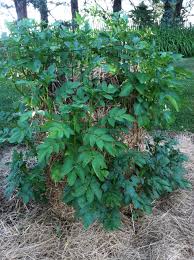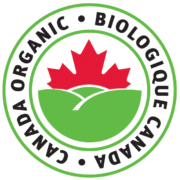Tips for Growing Potatoes in Towers & Containers
|
5 Tips to a Successful Potato Tower
Here are a couple ideas for potato planters & towers. For those with little or no garden space planting
 potatoes in containers is a great way of containing their massive growth habits. Use these tips to grow healthy potatoes and harvest maximum yields. potatoes in containers is a great way of containing their massive growth habits. Use these tips to grow healthy potatoes and harvest maximum yields.#1 Choose the right variety
With over 30 varieties to choose from in our catalogue it is hard to know which will perform best. Definitely stay away from the Early Season Varieties. Not that these won’t grow, only they won’t produce a lot of potatoes.
Not an issue in gardens with lots of space where you can plant more to make up for the low set. In containers you want varieties that set loads of potatoes. Mid Season, Late Season & Fingerling Varieties tend to have growth habits that allow them to continue to set more potatoes throughout the season. Pink Fir Apple for instance can set up to 30 potatoes on one plant! Many gardeners have reported excellent results with Bintje, German Butterball & fingerlings. #2 Soil
It is common to grow flowers in a peat moss, not a great idea for potatoes unless you want to eat potatoes that taste like peat, trust me, they don’t taste great. The flavour of potatoes is largely dependent on the soil we grow them in, which is why PEI Potatoes, if you have eaten any grown there, are known for their flavour. There is something in the red soil on the island that produces a unique flavour. Interestingly it is not a good idea to use 100% soil in a container or potato tower. You will find the soil may become extremely compressed caused by watering in large volumes form the top. Peat & Perlite help to ensure adequate air space within the soil to ensure healthy plants.
It is definitely ok to use up to 50% peat in your container or growing bag or tower if you do not have access to soil. Definitely mix in soil (max 60-70%), compost(must be properly composted), perlite (important for maintaining adequate moisture and air) and straw. I have done a 50% peat, 20% soil, 10% perlite, 5%straw &15% compost before that worked great. The ratios can be adjusted to suit what you have available or are can pick up at the local garden center.
#3 Nutrition
Unlike growing in the soil of your garden, there will be very little base nutrition in your container for your potatoes to draw from, especially if you are planting numerous potatoes in one container or tower. Potatoes are heavy feeders so if you do not fertilize throughout the summer you may end up with very few potatoes at harvest.
Fortunately there are plenty of fertilizers available at garden centres these days, I do not have experience with synthetic fertilizers, only organic options that can be sprinkled into the soil prior to planting or others that can be added to the watering. I prefer a bit of both, but you don’t want to have too much Nitrogen in the soil at any point as this can cause your plants to grow excessive leaves and very few potatoes. Compost added to the soil when you plant your potatoes, which can be made in your backyard from food scraps, is a great alternative to purchasing fertilizers.
#4 Design
Pots
Not really a tower, but definitely an option for those who do not have a garden to grow in. Pots
work great for potatoes, but they need to be a big pot 5 gallon is a good size. The problem with smaller pots is that on a hot windy day mid summer, you can water in the morning, but by 1:00pm the plant may have used up all the water and be wilted by the time you get home. Towers –There are 2 designs with potato towers.
Stackable towers -The first where you plant the potato at the bottom and as the potato grows you tubers up the stem. In this type of potato tower I would only plant 2-3 potatoes in a tower that would have a dimensions of 2 feet by 2 feet and 3 feet tall. If you plant more the potato plants will be very crowded growing out the top of the tower and will compete for light, limiting the the final yield.  For the Stackable towers, you will need to decide what you will use to contain the plants. This can be a wooden frame that you screw more boards on as the plants grow and you add soil. or a meshed frame that allows light to pass For the Stackable towers, you will need to decide what you will use to contain the plants. This can be a wooden frame that you screw more boards on as the plants grow and you add soil. or a meshed frame that allows light to pass through, but will contain the soil as the plants grow up. I have also seen grow bags at a few garden centers that you can pull up the side of the bag as you add soil throughout the season. Regardless of the structure, start with your mixed soil (6-10inches) in the bottom with 2-3 potatoes covered with only 1 inch of soil. As the plants grow, continue to add soil around the base of the plants. through, but will contain the soil as the plants grow up. I have also seen grow bags at a few garden centers that you can pull up the side of the bag as you add soil throughout the season. Regardless of the structure, start with your mixed soil (6-10inches) in the bottom with 2-3 potatoes covered with only 1 inch of soil. As the plants grow, continue to add soil around the base of the plants.Recommended varieties for stackable towers include, Pink Fir Apple, Linzer Delekatess, Russain Blue & Bintje,
Pre-planted Tower -This type involves building a tower, similar to the picture with mesh and when you fill the tower with soil all in one go, as you are filling the tower every 8 to 10 inches place some potatoes in the soil 3-4 inches from the edge of the
 tower. The straw that you see in the picture is to hold the dirt from falling out the holes in the mesh. tower. The straw that you see in the picture is to hold the dirt from falling out the holes in the mesh.I would limit the number of potatoes in this system to 8-10 in a 2 foot by 2 foot at 3 feet high. This system will take a few more seed potatoes to plant but has a much higher success rate. Instead of trying to trigger 2 or 3 potatoes to produce a huge amount of potatoes, the goal is to maximize your harvestable weight of potatoes in a small area. I would recommend using fingerling varieties & mid+late season varieties in this type of tower.
#5 Water
How much water? Just enough.. I know that sounds silly, but enough water to keep the pot or tower from drying out. The time you need to keep a really close eye on the potatoes is in Late July and August. By this time of the summer, you will have loads of potato leaves growing out of your tower which will be sucking loads of water. To compound the water draw, the potato tower is build above ground, unable to draw on the water within the soil and with an increased risk of the wind drying out the tower. Unless it is raining, you may need to water your tower once a day. If you are growing in a pot, definitely once, maybe even twice a day if your pot is in full sun. |
Organic Farm Transition
Many of you know that we have been transitioning our farm to Organic Production for the past 5 years. Although Certification for our Seed Potato crops is still a couple years away, we are happy to announce that we have successfully eliminated all synthetic inputs in our 2015 crop.
The reason it has taken a few years is, not only did we need to work out all the kinks of growing 30 acres of seed potatoes organically, we also needed to collect the equipment needed to grow grains and forages on an additional 200 organic acres of land. This additional land is what we use to rotate the potatoes through a healthy 7 year rotation to avoid disease issues in the crop. Although our farm was traditionally a grain farm, in the early 90’s we sold all our old grain and hay
equipment to focus on growing potatoes. You can see in the pictures there is nothing new about the equipment we sourced, the combine is 30 years old and the baler 40 years old. At 200 acres, our grain production is approximately 4% the size of of most of our neighbouring Alberta grain farmers, so fancy new equipment is definitely not an option. From our family to yours, we wish you a Happy New Year & a Fantastic 2016 gardening season. |




 need to add soil and add layers to the wall increasing the height of the tower at each stage( I would recommend a fingerling variety for this system) The idea is that, covering the stems will trigger them into producing more potatoes up the height of the tower. Although there are many success stories with this type of system, there are an equal number of people who tell me it didn’t work. The reason why the fingerlings will work better is they are more likely to continue producing
need to add soil and add layers to the wall increasing the height of the tower at each stage( I would recommend a fingerling variety for this system) The idea is that, covering the stems will trigger them into producing more potatoes up the height of the tower. Although there are many success stories with this type of system, there are an equal number of people who tell me it didn’t work. The reason why the fingerlings will work better is they are more likely to continue producing


